Sustainable Scaling of Climate-Smart Agricultural Technologies and Practices in Sub-Saharan Africa: The Case of Kenya, Malawi, and Nigeria
Abstract
1. Introduction
2. Materials and Methods
2.1. Description of Study Area
2.2. Research Design
Sampling and Sample Size
2.3. Analytical Technique
Multivariate Probit Regression
3. Results
3.1. Practices Associated with Climate-Smart Agriculture Kenya, Malawi, and Nigeria
3.2. Existing Climate-Smart Agricultural Technologies in Kenya, Malawi, and Nigeria
3.3. Climate-Smart Agricultural Practices’ Adoption and Preference by Gender in Kenya
3.4. Climate-Smart Agricultural Practices’ Adoption and Preference by Gender in Malawi
3.5. Climate-Smart Agricultural Practices’ Adoption and Preference by Gender Categories in Nigeria
3.6. Climate-Smart Agricultural Practices’ Preference by Gender Categories in Kenya, Malawi, and Nigeria
3.7. Multivariate Probit (MVP) Estimates of Factors Influencing Climate-Smart Agriculture Adoption
4. Conclusions
Author Contributions
Funding
Informed Consent Statement
Data Availability Statement
Acknowledgments
Conflicts of Interest
Appendix A
| Coefficient | Std. Err. | Z | |
|---|---|---|---|
| rho21 | 0.096 | 0.086 | 1.11 |
| rho31 | −0.077 | 0.089 | −0.87 |
| rho41 | −0.237 ** | 0.095 | −2.49 |
| rho51 | −0.190 ** | 0.092 | −2.06 |
| rho61 | −0.076 | 0.087 | −0.87 |
| rho32 | −0.170 ** | 0.082 | −2.06 |
| rho42 | 0.106 | 0.091 | 1.16 |
| rho52 | −0.164 ** | 0.079 | −2.07 |
| rho62 | −0.178 ** | 0.087 | −2.06 |
| rho43 | 0.134 | 0.094 | 1.42 |
| rho53 | −0.217 ** | 0.081 | −2.68 |
| rho63 | −0.003 | 0.081 | −0.04 |
| rho54 | 0.042 | 0.088 | 0.47 |
| rho64 | −0.285 *** | 0.089 | −3.19 |
| rho65 | −0.300 *** | 0.081 | −3.7 |
References
- Fischer, G.; Shah, M.; van Velthuizen, H. Climate Change and Agricultural Vulnerability. In Contribution to the World Summit on Sustainable Development, Johannesburg; International Institute for Applied Systems Analysis (IAASA): Laxenburg, Austria, 2002. [Google Scholar]
- IPCC. Contribution of Working Group II to the Fourth Assessment Report of the Intergovernmental Panel on Climate Change. In Climate Change 2007, Fourth Assessment Report, Intergovernmental Panel on Climate Change; Parry, M.L., Canziani, O.F., Palutikof, J.P., van der Linden, P.J., Hanson, C.E., Eds.; Cambridge University Press: Cambridge, UK; New York, NY, USA, 2007; Available online: http://www.ipcc.ch/publications_and_data/ar4/wg2/en/contents.html (accessed on 18 March 2022).
- FAO. Climate-Smart Agriculture: Sourcebook; Food and Agriculture Organization of the United Nations: Rome, Italy, 2013. [Google Scholar]
- Vermeulen, J.J.; Campbell, B.M.; Ingram, S.J.I. Climate Change and Food Systems. Ann. Rev. Envorin. Res. 2012, 37, 195–222. [Google Scholar] [CrossRef]
- Funders, M.; Fjalland, J.; Ravnborg, H.M.; Egelind, H. Low carbon development and poverty alleviation. In DIIS Report 2009:20; Danish Institute for International Studies: Copenhagen, Denmark, 2009. [Google Scholar]
- Smith, P.; Martino, D.; Cai, Z.; Gwary, D.; Janzen, H.; Kumar, P.; McCarl, B.; Ogle, S.; O’Mara, F.; Rice, C.; et al. Agriculture. In Mitigation Contribution of WG III to the Fourth Assessment Report of the Intergovernmental Panel on Climate Change; Metz, B., Davidson, O., Bosch, P., Dave, R., Meyer, L., Eds.; Cambridge Press: Cambridge, UK, 2007. [Google Scholar]
- Hundera, H.; Mpandeli, S.; Bantider, A. Smallholder farmers’ awareness and perceptions of climate change in Adama district, central rift valley of Ethiopia. Weather Clim. Extremes 2019, 26, 100230. [Google Scholar] [CrossRef]
- Makate, C.; Makate, M.; Mango, N. Sustainable agriculture practices and livelihoods in pro-poor smallholder farming systems in southern Africa. Afr. J. Sci. Technol. Innov. Dev. 2017, 9, 269–279. [Google Scholar] [CrossRef]
- Mango, N.; Nyikahadzoi, K.; Makate, C.; Dunjana, N.; Siziba, S. The impact of integrated agricultural research for development on food security among smallholder farmers of southern Africa. Agrekon 2015, 54, 107–125. [Google Scholar] [CrossRef]
- Kurgat, B.K.; Lamanna, C.; Kimaro, A.; Namoi, N.; Manda, L.; Rosenstock, T.S. Adoption of Climate-Smart Agriculture Technologies in Tanzania. Front. Sustain. Food Syst. 2020, 4, 55. [Google Scholar] [CrossRef]
- CCAFS. Big facts on climate change Agriculture and Food security. In CGIAR Research Program on Climate Change; Agriculture and Food Security (CCAFS): Copenhagen Denmark, 2013. [Google Scholar]
- FAO. Climate Change and Agriculture Scenarios for Malawi. Socio-Economic Scenarios. 2013. Available online: http://www.fao.org/climatechange/epic (accessed on 9 July 2022).
- De Pinto, A.; Cenachi, N. Study Suggests that Climate Smart Agriculture Can Boost Yields, Reduce Hunger and Emissions Globally. 2020. Available online: https://www.ifpri.org/blog/study-suggests-climate-smart-agriculture-can-boost-yields-reduce-hunger-and-emissions-globally (accessed on 3 March 2022).
- Oyawole, F.P.; Dipeolu, A.O.; Shittu, A.M.; Obayelu, A.E.; Fabunmi, T.O. What Drives the Adoption of Climate Smart Agricultural Practices? Evidence from Maize Farmers in Northern Nigeria. Niger. J. Agric. Econ. 2019, 9, 14–28. [Google Scholar]
- Sombroek, W.G.; Braun, H.M.H.; van der Pouw, B.J.A. Exploratory Soil Map and Agro-Climatic Zone Map of Kenya, 1980. Scale: 1:1,000,000. In Exploratory Soil Survey Report No. E1. Kenya Soil Survey; Ministry of Agriculture-National Agricultural Laboratories: Nairobi, Kenya, 1982. [Google Scholar]
- GGAPM. Synthesizing Agricultural Research Findings in Malawi Guide to Good Agriculture Practices in Malawi. 2019. Available online: http://sapp.mw/wp-content/uploads/2019/09/Updated-SAPP-Guide-to-Good-Agricultural-Practices-Final.pdf (accessed on 3 June 2022).
- Alamu, O.T.; Amao, A.O.; Nwokedi, C.I.; Oke, O.A.; Lawa, I.O. Diversity and nutritional status of edible insects in Nigeria: A review. Int. J. Biodivers. Conserv. 2013, 5, 215–222. [Google Scholar]
- Kilgore, M.A.; Snyder, S.; Taff, S.; Schertz, J. Family forest stewardship: Do owners need a financial incentive? J. For. 2008, 106, 357–362. [Google Scholar]
- Afolami, C.A.; Obayelu, A.E.; Vaughan, I.I. Welfare impact of adoption of improved cassava varieties by rural households in South Western Nigeria. Agric. Food Econ. 2015, 3, 1–17. [Google Scholar] [CrossRef]
- Fisher, M.; Abate, T.; Lunduka, R.W.; Asnake, W.; Alemayehu, Y.; Madulu, R.B. Drought tolerant maize for farmer adaptation to drought in sub-Saharan Africa: Determinants of adoption in eastern and southern Africa. Clim. Change 2015, 133, 283–299. [Google Scholar] [CrossRef]
- Lukuyu, B.; Place, F.; Franzel, S.; Kiptot, E. Disseminating Improved Practices: Are Volunteer Farmer Trainers Effective? J. Agric. Educ. Ext. 2012, 18, 525–540. [Google Scholar] [CrossRef]
- Mafongoya, P.; Bationo, A.; Kihara, J.; Waswa, B. Appropriate technlogies to replenish soil fertility in southern Africa Nutrient. Nutr. Cycl. Agroecosyst. 2006, 76, 137–151. [Google Scholar] [CrossRef]
- Nyamangara, J.; Mtambanengwe, F.; Musvoto, C. Carbon and nitrogen mineralization from selected organic resources available to smallholder farmers for soil fertility improvement in Zimbabwe. Afr. J. Agric. Res. 2009, 4, 870–877. [Google Scholar]
- Mohler, C.L.; Johnson, S.E. Crop Rotation and Farm Management; SARE Outreach: College Park, MD, USA, 2009. [Google Scholar]
- Kaumbutho, P.; Kienzle, J. Conservation Agriculture as Practiced in Kenya: Two Case Studies; Nairobi, African Conservation Tillage Network, Centre de Coopération Internationale de Recherche Agronomique pour le Développement, Food and Agriculture Organization of the United Nations: Paris, Italy, 2007. [Google Scholar]
- Singhal, V.; Ghosh, J.; Jinger, D. Cover crop technology-a way towards conservation agriculture: A review (11) (PDF) Cover crop technology -a way towards conservation agriculture: A review. Indian J. Agric. Sci. 2020, 90, 2275–2284. [Google Scholar]
- Heuzé, V.; Tran, G.; Hassoun, P.; Bastianelli, D.; Lebas, F. Tropical Kudzu (Pueraria phaseoloides). Feedipedia, a Programme by INRA, CIRAD, AFZ and FAO. 2016. Last Updated on 13 September 2016, 0:57. Available online: http://www.feedipedia.org/node/257 (accessed on 5 July 2022).
- Iqbal, R.; Raza, M.A.S.; Valipour, M.; Saleem, M.F.; Zaheer, M.S.; Ahmad, S.; Toleikiene, M.; Haider, I.; Aslam, M.U.; Nazar, M.A. Potential agricultural and environmental benefits of mulches-a review. Bull. Natl. Res. Cent. 2020, 44, 1–16. [Google Scholar]
- Scheumann, W.; Annabelle Houdret, A.; Brüntrup, M. Unlocking the Irrigation Potential in Sub-Saharan Africa: Are Public Private Partnerships the Way Forward? 2017. Available online: https://www.die-gdi.de/uploads/media/BP__7.2017.pdf (accessed on 28 June 2022).
- Bjornlund, H.; van Rooyen, A.; Pittock, J.; Parry, K.; Moyo, M.; Mdemu, M.; de Sousa, W. Institutional innovation and smart water management technologies in small-scale irrigation schemes in southern Africa. Water Int. 2020, 45, 621–650. [Google Scholar] [CrossRef]
- Saiz, G.; Wandera, F.M.; Pelster, D.E.; Ngetich, W.; Okalebo, J.R.; Rufino, M.C.; Butterbach-Bahl, K. Long-term assessment of soil and water conservation measures (Fanya-juu terraces) on soil organic matter in South Eastern Kenya. Geoderma 2016, 247, 1–9. [Google Scholar] [CrossRef]
- El-Shater, T.; Yigezu, Y.A. Can Retention of Crop Residues on the Field Be Justified on Socioeconomic Grounds? A Case Study from the Mixed Crop-Livestock Production Systems of the Moroccan Drylands. Agronomy 2021, 11, 1465. [Google Scholar] [CrossRef]
- Van Huis, A. Challenges of integrated pest management in sub-Saharan Africa. In Integrated Pest Management: Dissemination and Impact; Peshin, R., Dhawan, A.K., Eds.; Springer: Dordrecht, The Netherlands, 2009; pp. 395–417. [Google Scholar]
- Kiyani, P.; Andoh, J.; Lee, Y.; Lee, D.K. Benefits and challenges of agroforestry adoption: A case of Musebeya sector, Nyamagabe District in southern province of Rwanda. For. Sci. Technol. 2017, 13, 174–180. [Google Scholar] [CrossRef]
- Aroka, N. Rainwater Harvesting in Rural Kenya: Reliability in a Variable and Changing Climate. Independent Thesis Advanced level (degree of Master (Two Years)), Stockholm University, Faculty of Science, Department of Physical Geography and Quaternary Geology (INK), Stockholm, Sweden, 2010. Available online: http://www.diva-portal.org/smash/record.jsf?pid=diva2%3A354235&dswid=7866 (accessed on 15 May 2022).
- Duguna, F.A.; Januszkiewicz, K. Rainwater in Ethiopia as A New Energy Resources. New Approach to Sustainable Development in the Mountain Area. IOP Conf. Series Mater. Sci. Eng. 2019, 471, 082016. [Google Scholar] [CrossRef]
- IFDC. Soaring Fertilizer Prices: A Threat to Food Security in Sub-Saharan Africa. 2021. Available online: https://ifdc.org/2021/12/20/soaring-fertilizer-prices-a-threat-to-food-security-in-sub-saharan-africa/ (accessed on 22 April 2022).
- Abegunde, V.O.; Sibanda, M.; Obi, A. The Dynamics of Climate Change Adaptation in Sub-Saharan Africa: A Review of Climate-Smart Agriculture among Small-Scale Farmers. Climate 2019, 7, 132. [Google Scholar] [CrossRef]
- Tran, N.L.D.; Rañola, R.F.; Ole Sander, B.; Reiner, W.; Nguyen, D.T.; Nong, N.K.N. Determinants of adoption of climate-smart agriculture technologies in rice production in Vietnam. Int. J. Clim. Chang. Strat. Manag. 2019, 12, 238–256. [Google Scholar] [CrossRef]
- Ehiakpor, D.S.; Danso-Abbeam, G.; Dagunga, G.; Ayambila, S.N. Impact of Zai technology on farmers’ welfare: Evidence from northern Ghana. Technol. Soc. 2019, 59, 101189. [Google Scholar] [CrossRef]
- Maguza-tembo, F.; Mangison, J.; Edris, A.K.; Kenamu, E. Determinants of adoption of multiple climate change adaptation strategies in southern Malawi: An ordered Probit analysis. J. Dev. Agric. Econ. 2017, 9, 1–7. [Google Scholar] [CrossRef]
- Ghimire, R.; Huang, W.C.; Coulibaly, J.Y.; Chiputwa, B.; Nakelse, T.; Kundhlande, G. Adoption of Agroforestry and Its Impact on Household Food Eecurity among Farmers in Malawi; ICRAF Working Paper No. 223. Agric. Syst. 2017, 155, 52–69. [Google Scholar]
- Mujeyi, A.; Mudhara, M.; Mutenje, M.J. Adoption determinants of multiple climate smart agricultural technologies in Zimbabwe: Considerations for scaling-up and out. Afr. J. Sci. Technol. Innov. Dev. 2019, 12, 1–12. [Google Scholar]
- Ndiritu, S.W.; Kassie, M.; Shiferaw, B. Are there systematic gender differences in the adoption of sustainable agricultural intensification practices? Evidence from Kenya. Food Policy 2014, 49, 117–127. [Google Scholar] [CrossRef]
- Faleye, O.S.; Afolami, C.A. Determinants of choice of Climate Smart Agricultural practices adoption among yam-based farming households in Ogun State, Nigeria. J. Agric. Sci. Pract. 2020, 5, 131–141. [Google Scholar] [CrossRef]
- Ukoje, J.A.; Yusuf, R.O. Organic fertilizer: The underestimated component in agricultural transformation initiatives for sustainable small holder farming in Nigeria. Ethiop. J. Environ. Stud. Manag. 2013, 6, 794. [Google Scholar] [CrossRef]
- Akinbode, W.O.; Bamire, A.S. Determinants of adoption of improved maize varieties in Osun state, Nigeria. J. Agric. Ext. Manag. 2015, 7, 65–72. [Google Scholar]
- Oladele, O.I.; Chimewah, A.N.; Olorunfemi, O.D. Determinants of farmers’ adoption of alternate wet and dry techniques in lowland rice production in Ghana, Uganda and Cameroon for climate smart agriculture. J. Dev. Areas 2019, 53, 170–181. [Google Scholar] [CrossRef]
- Kassie, M.; Teklewold, H.; Jaleta, M.; Marenya, P.; Erenstein, O. Understanding the adoption of a portfolio of sustainable intensification practices in eastern and southern Africa. Land Use Policy 2015, 42, 400–411. [Google Scholar] [CrossRef]
- Wossen, T.; Abdoulaye, T.; Alene, A.; Haile, M.G.; Feleke, S.; Olanrewaju, A.; Manyong, V. Impacts of extension access and cooperative membership on technology adoption and household welfare. J. Rural Stud. 2017, 54, 223–233. [Google Scholar] [CrossRef] [PubMed]
- Kassie, M.; Stage, J.; Diiro, G.; Muriithi, B.; Muricho, G.; Ledermann, S.T.; Midega, C.; Khan, Z. Push–pull farming system in Kenya: Implications for economic and social welfare. Land Use Policy 2018, 77, 186–198. [Google Scholar]

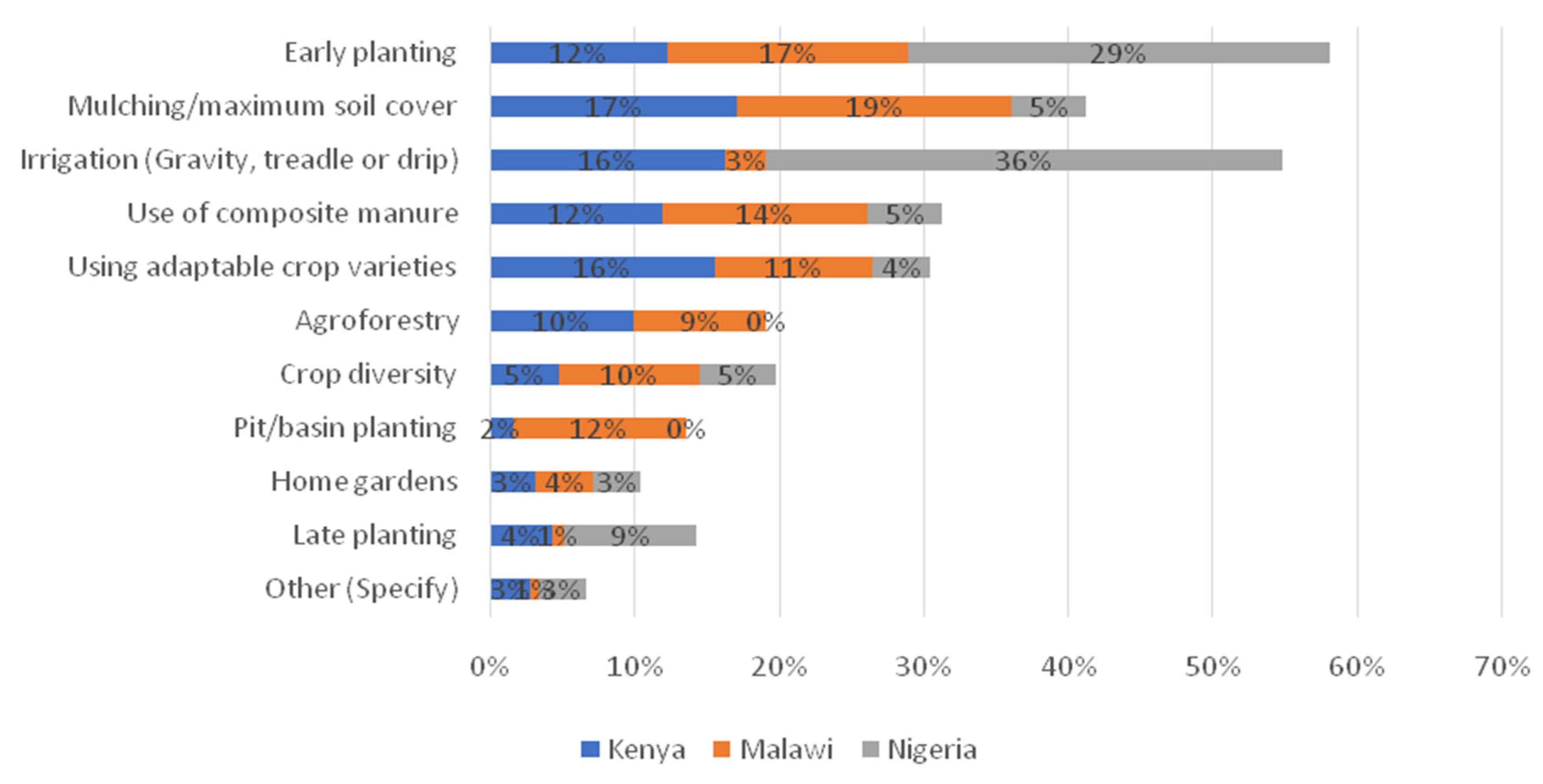
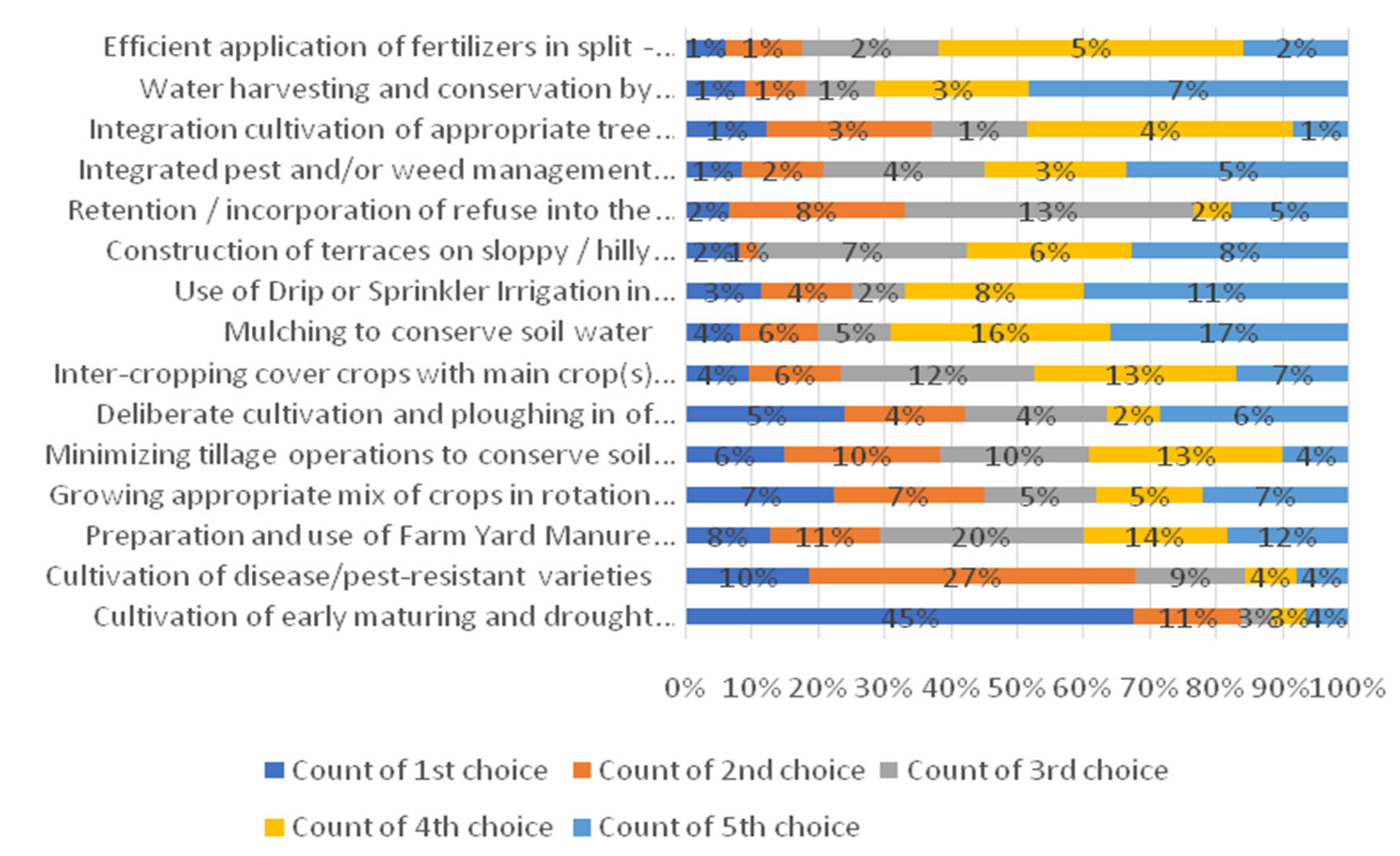
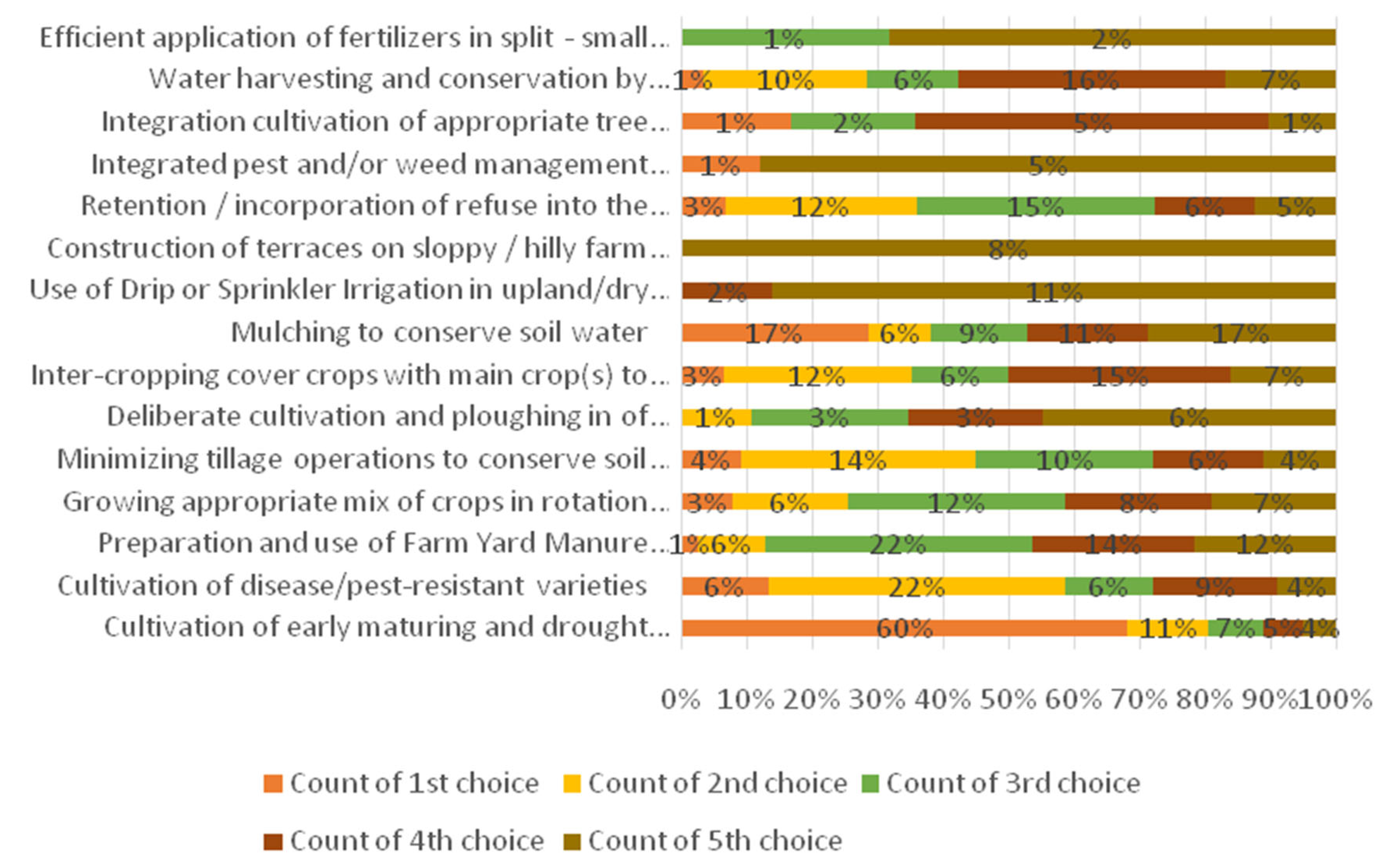
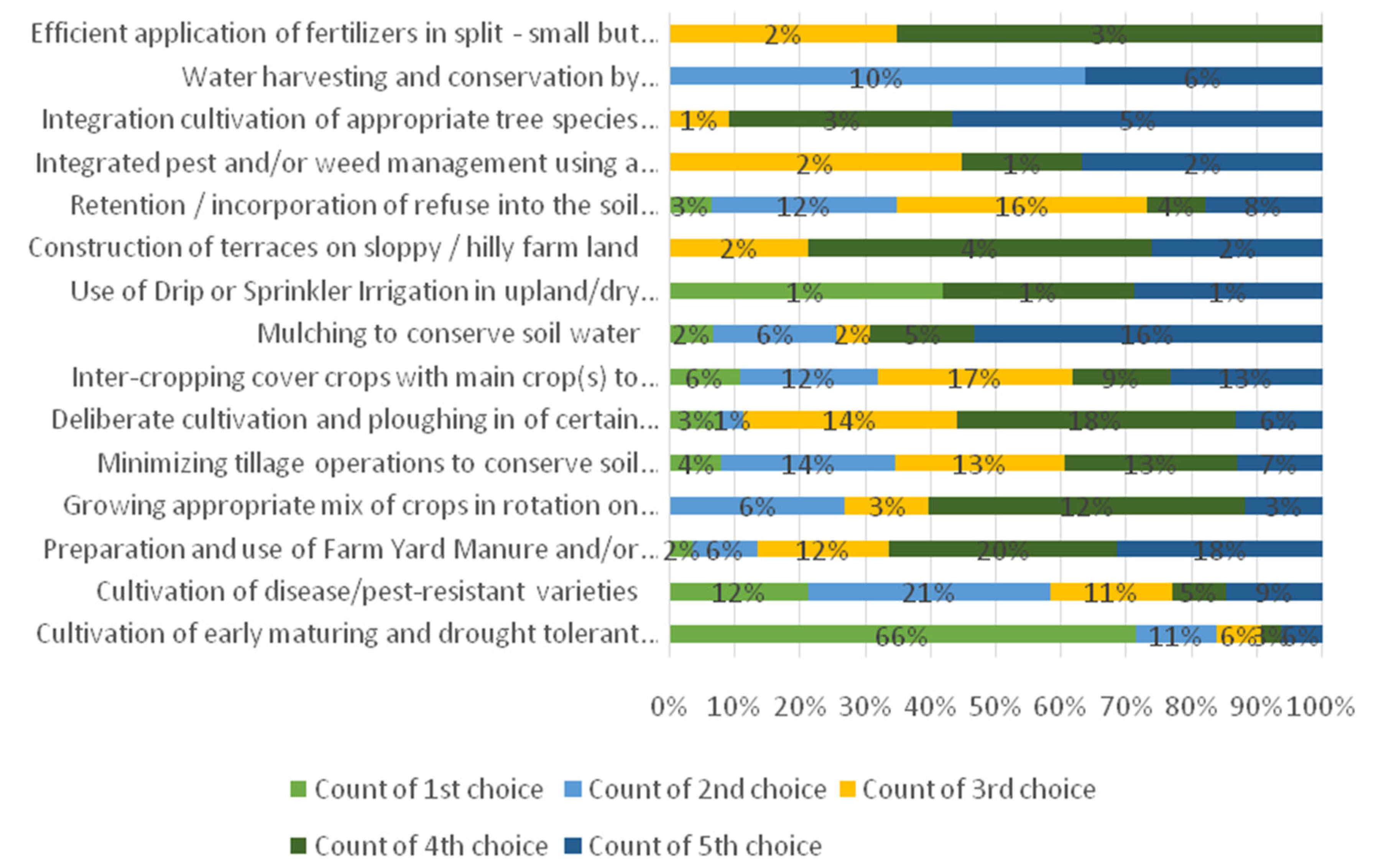
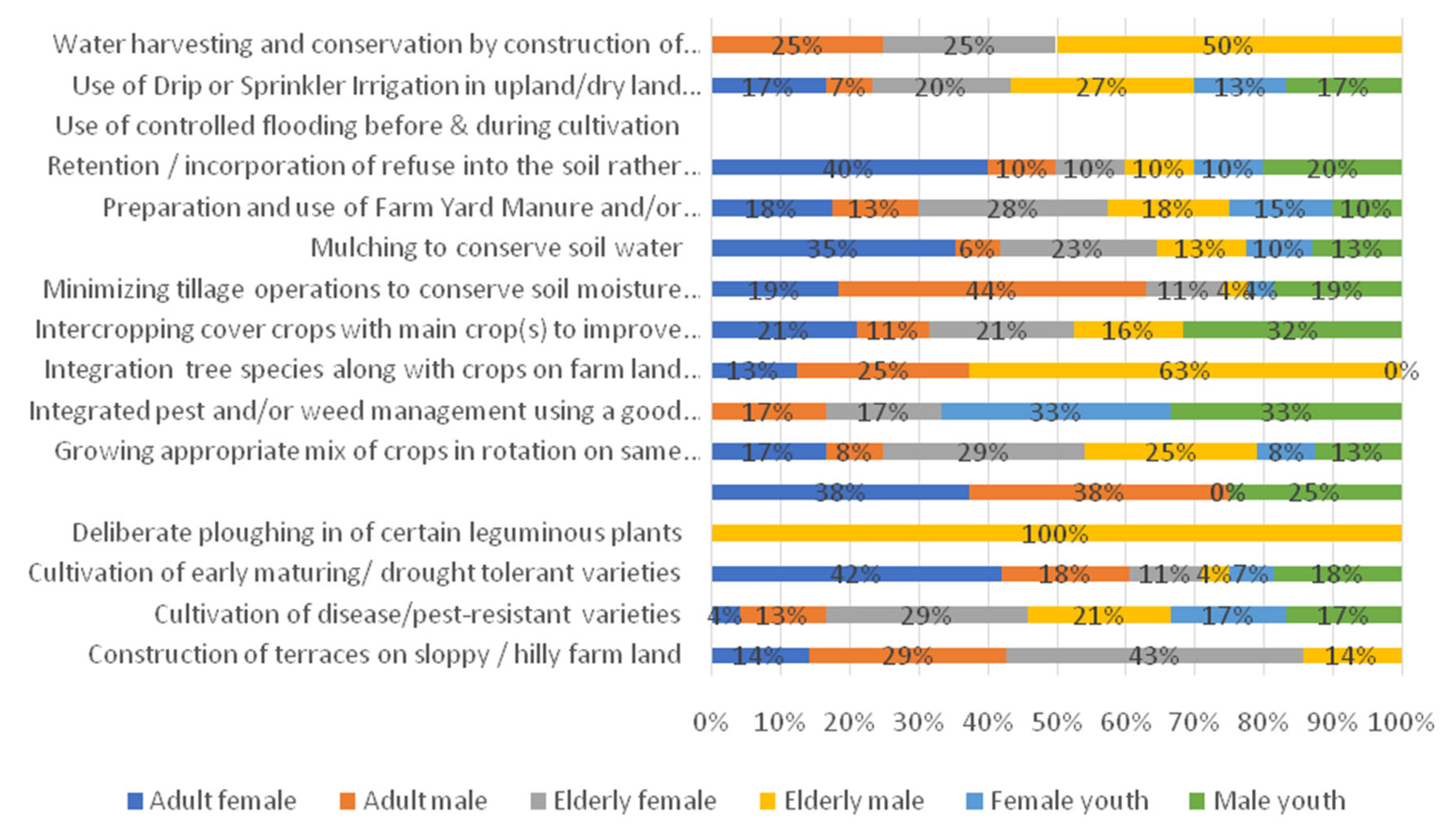


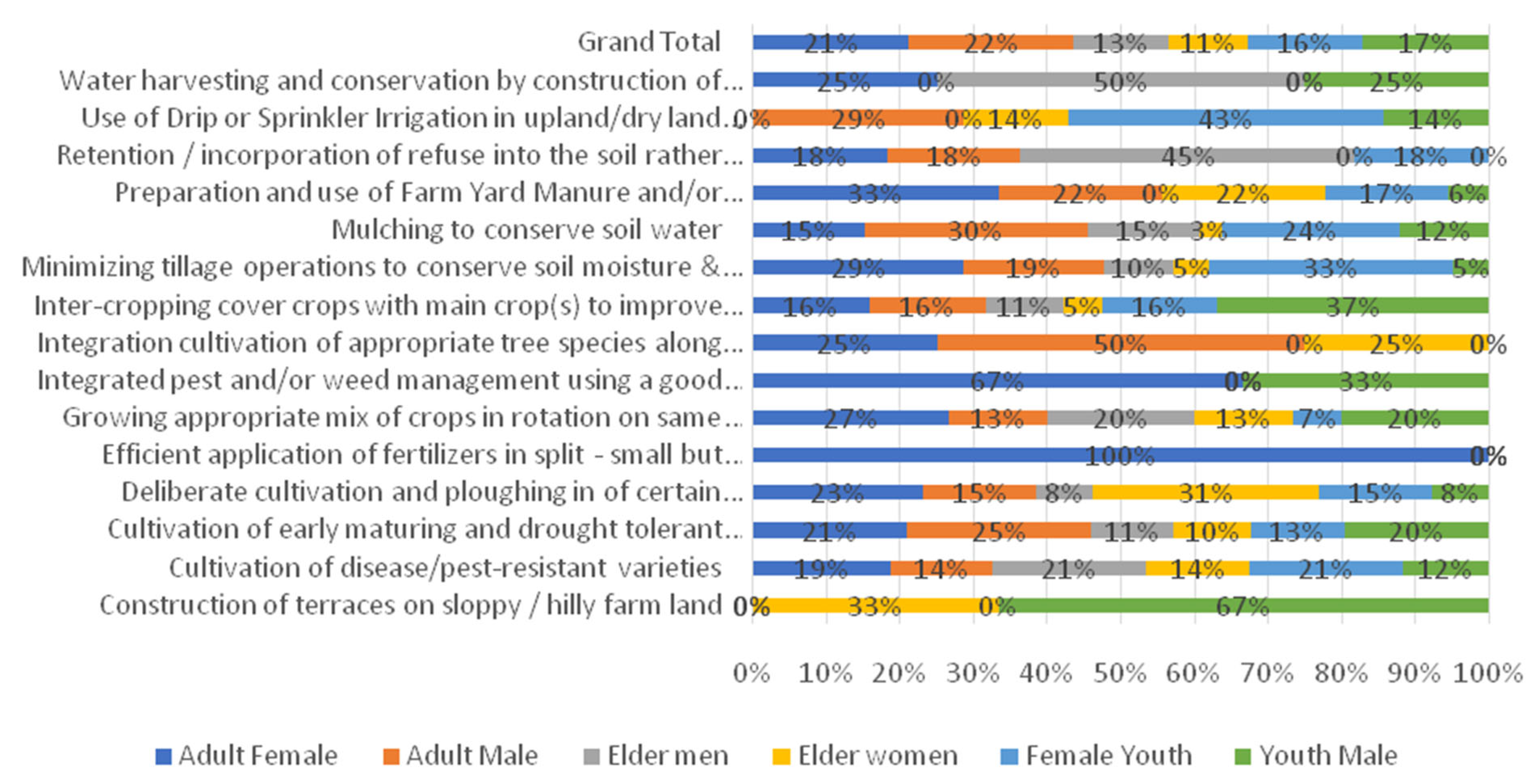
| Variable | Description |
|---|---|
| Climate | Smart Agricultural Practices’ Adoption |
| CSAP1 | If plot manager adopts CSAP1= 1, otherwise |
| CSAP2 | If plot manager adopts CSAP2 = 1, otherwise 0 |
| CSAP3 | If plot manager adopts CSAP3= 1, otherwise 0 |
| CSAP4 | If plot manager adopts CSAP4 = 1, otherwise 0 |
| CSAP5 | If plot manager adopts CSAP5 = 1, otherwise 0 |
| CSAP6 | If plot manager adopts CSAP6= 1, otherwise 0 |
| Socioeconomic characteristics | |
| Age | Age of the Plot manager |
| Sex | If plot manager is male = 1, otherwise = 0 |
| Marital Status | If the plot manager is married = 0; Otherwise = 1 |
| Years of Schooling | Years of formal education of the plot manager |
| Household size | Number of household members |
| Off-farm Income | Plot manager’s total off-farm income in the last year ( ) ) |
| Asset ownership | 1 if the plot manager owns a major asset – (such as land, buildings, machinery) |
| Farmers’ Group membership | If the plot manager is a member = 0; Otherwise = 1 |
| Institutional characteristics | |
| Extension Contact | 1 if an agricultural extension agent visited the plot manager or if the plot manager visited extension service office during last planting season, 0 otherwise |
| Access to credit | 1 if the plot manager received credit, 0 otherwise |
| Plot characteristics | |
| Farm Size (Ha) | Size of the plot cultivated by the plot manager in hectares |
| Lowland | If Plot is lowland = 1; Otherwise = 0 |
| Land ownership status | If plot manager owns the plot = 1; Otherwise = 0 |
| Plot Trekking distance from home | Number of minutes used in trekking to the plot |
| Land dispute | 1 if plot manager ever experienced dispute, 0 otherwise |
| Fertilizer Use | If plot manager used inorganic fertilizer on the Plot = 1; Otherwise = 0 |
| Variables | Early Maturing Var. | Refuse Retention | Minimum Tillage | Green Manure | Crop Rotation | Mulching | ||||||
|---|---|---|---|---|---|---|---|---|---|---|---|---|
| Coeff. | Z | Coeff. | Z | Coeff. | Z | Coeff. | Z | Coeff. | Z | Coeff. | Z | |
| Gender (adult male) | 0.910 ** (0.374) | 2.44 | −0.130 (0.312) | −0.42 | 0.275 (0.330) | 0.83 | 0.076 (0.336) | 0.23 | −0.599 * (0.334) | −1.79 | −0.195 (0.316) | −0.62 |
| Gender (adult female) | 0.575 (0.355) | 1.62 | 0.258 (0.328) | 0.78 | 0.419 (0.342) | 1.23 | 0.254 (0.356) | 0.71 | −0.348 (0.335) | −1.04 | −0.209 (0.330) | −0.63 |
| Gender (elderly female) | 0.510 * (0.261) | 1.95 | −0.083 (0.254) | −0.33 | 0.271 (0.262) | 1.03 | 0.399 (0.276) | 1.44 | −0.353 (0.258) | −1.37 | −0.092 (0.258) | −0.36 |
| Gender (male youth) | 1.022 * (0.525) | 1.95 | 0.302 (0.475) | 0.63 | −0.294 (0.498) | −0.59 | 0.587 (0.530) | 1.11 | −0.332 (0.487 | −0.68 | −0.670 (0.485) | −1.38 |
| Gender (female youth) | 0.865 (0.528) | 1.64 | 0.421 (0.469) | 0.90 | 0.346 (0.488) | 0.71 | 0.154 (0.545) | 0.28 | −0.111 (0.491) | −0.23 | −0.679 (0.481) | −1.41 |
| Age | 0.010 (0.013) | 0.77 | −0.004 (0.012) | −0.34 | −0.020 * (0.012) | −1.69 | 0.004 (0.013) | 0.29 | −0.005 (0.012) | −0.39 | −0.013 (0.012) | −1.16 |
| Educational level | −0.031 (0.019) | −1.60 | 0.012 (0.016) | 0.77 | −0.025 (0.016) | −1.57 | 0.037 ** (0.018) | 2.02 | −0.010 (0.016) | −0.63 | 0.016 (0.017) | 0.93 |
| Household size | 0.034 (0.032) | 1.06 | 0.004 (0.024) | 0.16 | −0.016 (0.024) | −0.66 | 0.036 (0.029) | 1.24 | 0.003 (0.025) | 0.13 | −0.124 *** (0.031) | −4.00 |
| Native | 0.000 (0.006) | 0.02 | 0.015 *** (0.006) | 2.61 | −0.002 (0.006) | −0.28 | −0.002 (0.005) | −0.38 | 0.001 (0.005) | 0.14 | 0.001 (0.005) | 0.11 |
| Flood incidence | 0.299 * (0.178) | 1.68 | 0.421 *** (0.172) | 2.45 | 0.640 *** (0.177) | 3.62 | −0.074 (0.179) | −0.41 | −0.125 (0.168) | −0.75 | 0.508 ** (0.176) | 2.88 |
| Drought incidence | 0.182 (0.169) | 1.08 | 0.104 (0.147) | 0.7 | 0.128 0.160 | 0.80 | 0.291 * (0.163) | 1.79 | −0.042 (0.161) | −0.26 | −0.108 (0.153) | −0.7 |
| Credit access | 0.117 (0.170) | 0.69 | −0.231 (0.153) | −1.51 | 0.365 ** (0.155) | 2.36 | 0.383 ** (0.171) | 2.24 | −0.242 (0.155) | −1.56 | −0.313 ** (0.151) | −2.07 |
| Membership of cooperative society | −0.170 (0.175) | −0.97 | −0.027 (0.162) | −0.16 | −0.324 ** (0.162) | −2.00 | 0.055 (0.182) | 0.3 | 0.159 (0.171) | 0.93 | −0.547 *** (0.172) | −3.19 |
| Farm size | 0.048 (0.031) | 1.55 | −0.017 (0.030) | −0.56 | 0.117 *** (0.025) | 4.68 | 0.009 (0.029) | 0.31 | −0.051 (0.033) | −1.57 | 0.026 (0.028) | 0.94 |
| Distance from home to farm | −0.006 * (0.003) | −1.76 | 0.000 (0.003) | −0.08 | 0.000 (0.003) | −0.04 | 0.004 * (0.002) | 1.80 | 0.002 (0.003) | 0.58 | 0.006 * (0.003) | 1.87 |
| Land type | −0.497 ** (0.196) | −2.53 | 0.151 (0.175) | 0.86 | 0.124 (0.181) | 0.68 | 0.466 ** (0.206) | 2.26 | 0.984 *** (0.203) | 4.86 | −0.393 ** (0.176) | −2.23 |
| Land ownership | −0.004 (0.181) | −0.02 | 0.000 (0.166) | 0.00 | −0.168 (0.167) | −1.01 | −0.485 *** (0.170) | −2.85 | −0.061 (0.174) | −0.35 | −0.138 (0.169) | −0.82 |
| Extension contacts | 0.702 *** (0.202) | 3.47 | 0.153 (0.197) | 0.78 | −0.218 (0.197) | −1.11 | 0.640 *** (0.225) | 2.85 | −0.077 (0.206) | −0.37 | 0.311 (0.194) | 1.60 |
| Off farm income ($) | 0.001 (0.001) | 1.11 | 0.000 (0.001) | −0.17 | 0.001 * (0.001) | 1.69 | 0.002 *** (0.001) | 2.82 | 0.001 (0.001) | 1.41 | −0.002 *** (0.001) | −2.79 |
| Household members that contributed to income (#) | −0.026 (0.059) | −0.45 | 0.000 (0.000) | 1.19 | −0.001 *** (0.000) | −4.13 | 0.000 (0.000) | 1.16 | 0.000 (0.000) | 0.06 | −0.001 *** (0.000) | −4.40 |
| Constant | −1.421 (0.985) | −1.44 | −1.632 (0.899) | −1.81 | −1.170 (0.919) | −1.27 | −3.300 (0.982) | −3.36 | 0.038 (0.961) | 0.04 | 1.170 (0.911) | 1.28 |
Publisher’s Note: MDPI stays neutral with regard to jurisdictional claims in published maps and institutional affiliations. |
© 2022 by the authors. Licensee MDPI, Basel, Switzerland. This article is an open access article distributed under the terms and conditions of the Creative Commons Attribution (CC BY) license (https://creativecommons.org/licenses/by/4.0/).
Share and Cite
Phiri, A.T.; Charimbu, M.; Edewor, S.E.; Gaveta, E. Sustainable Scaling of Climate-Smart Agricultural Technologies and Practices in Sub-Saharan Africa: The Case of Kenya, Malawi, and Nigeria. Sustainability 2022, 14, 14709. https://doi.org/10.3390/su142214709
Phiri AT, Charimbu M, Edewor SE, Gaveta E. Sustainable Scaling of Climate-Smart Agricultural Technologies and Practices in Sub-Saharan Africa: The Case of Kenya, Malawi, and Nigeria. Sustainability. 2022; 14(22):14709. https://doi.org/10.3390/su142214709
Chicago/Turabian StylePhiri, Austin Tenthani, Miriam Charimbu, Sarah Edore Edewor, and Elias Gaveta. 2022. "Sustainable Scaling of Climate-Smart Agricultural Technologies and Practices in Sub-Saharan Africa: The Case of Kenya, Malawi, and Nigeria" Sustainability 14, no. 22: 14709. https://doi.org/10.3390/su142214709
APA StylePhiri, A. T., Charimbu, M., Edewor, S. E., & Gaveta, E. (2022). Sustainable Scaling of Climate-Smart Agricultural Technologies and Practices in Sub-Saharan Africa: The Case of Kenya, Malawi, and Nigeria. Sustainability, 14(22), 14709. https://doi.org/10.3390/su142214709






